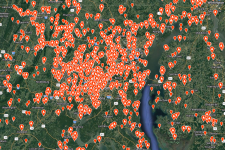Charlie Yardbird
Well-known member

We get hairy & downy woodpeckers at the suet. This guy is girdling my holly tree. It is two stories high & maybe 30" away from a second story window. At the height of the window he is making rounded rectangles 2cm x 2-4cm, not very deep, all around, for a vertical span of say 8" - its a thin smooth bark.
He does not have the white stripe down the spine like a hairy/downy. And he does not have red on the nape of the neck, but over the whole top of the head. His belly is mottled, grey with white (vs hairy/downy white, with some spots on the flanks). His back/wings are mottled black/grey/white but fuzzy; not distinctly spotted like the hairy/downy black & white.
I can't find it in my Audubon Field Guide. Wrong season for a yellow bellied sapsucker, and he does not look like that photo, no red on the front of the neck. But its been weird this year, have not gotten the flocks of several dozen, have not used much seed or suet.
He does not have the white stripe down the spine like a hairy/downy. And he does not have red on the nape of the neck, but over the whole top of the head. His belly is mottled, grey with white (vs hairy/downy white, with some spots on the flanks). His back/wings are mottled black/grey/white but fuzzy; not distinctly spotted like the hairy/downy black & white.
I can't find it in my Audubon Field Guide. Wrong season for a yellow bellied sapsucker, and he does not look like that photo, no red on the front of the neck. But its been weird this year, have not gotten the flocks of several dozen, have not used much seed or suet.






